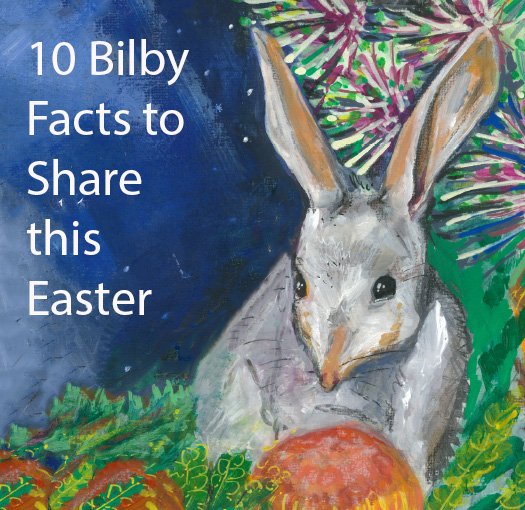10 bilby facts to share with your class or family this Easter
Easter Bilby, Illustration by Sarah Matsuda
There is so much to love about bilbies. As super-charged-burrow-builders, bilbies help turn the soil, decompose leaf litter and provide homes for other small animals. They are also a uniquely Australian Easter mascot. Here are 10 bilby facts to share with your class or family this Easter:
1. Bilbies are excellent diggers. Their specially designed claws allow them to excavate spiral shaped burrows up to 3m long and 2m deep.
2. Bilbies frequently dig new burrows while abandoning old ones, creating shelters and for other animals (such as hopping mice) in the harsh arid/semi-arid environments where they live. Their burrows even provide shelter for other animals during a bushfire.
3. As they dig for food, bilbies make small furrows in the soil. These small holes collect seeds, leaves and moisture, helping plants germinate and grow.
4. Bilbies are marsupials (mammals with a pouch). They have one or two young at a time (and very rarely 3), although not all baby bilbies survive to adulthood.
5. A bilby’s pouch faces backwards, so that mother bilby doesn’t get dirt on her baby as she digs a burrow or searches for food.
6. Bilbies have soft, grey fur, a long tail with a black tuft on the end and large pointed ears.
7. The bilby’s large oversized ears work like inbuilt air-conditioning systems. The bilby’s blood circulates around the large surface area of the bilby’s ears and then returns cooling the bilby’s overall body temperature. This is just one of the many ways the bilby has adapted to Australia’s deserts.
8. Bilbies are omnivores. Although they have poor eyesight, they have a keen sense of smell. They use their long-pointed snouts to search out termites, spiders, seeds and roots. Bilbies particularly love termites and lick them up with their long, sticky tongue.
9. Like many native burrowing mammals, bilbies are often referred to as “ecosystem engineers” because of the important role they play in keeping our environment healthy.
10. Bilbies are now very rare. The greater bilby once occupied a range of habits across 70% of the Australian mainland. Sadly, bilbies now live only in isolated areas in arid and semi-arid regions in Northern and Central Australia. Their cousin the lesser bilby became extinct in the 1950s. Unfortunately, many of Australia’s small ground dwelling mammals are now endangered due to the key threats posed by introduced predators: feral cats and the European red fox as well as degradation caused by cattle and European rabbits.
The Easter Bilby campaign began in 1991 to raise awareness of the environmental destruction caused by introduced European rabbits and to raise awareness of the plight of the greater bilby. To find out why it’s important to celebrate bilbies not bunnies this Easter read our previous blog post.
Cate Storey is a children’s author and founder of Wet Season Books, her first book Snuggled Away will be released April 2022

